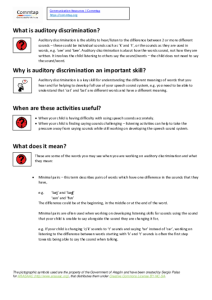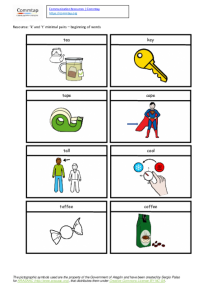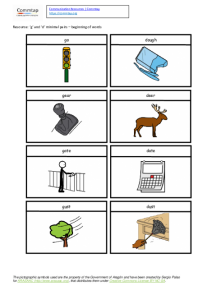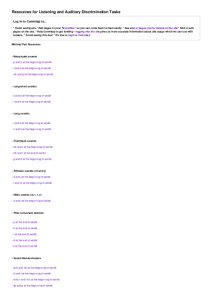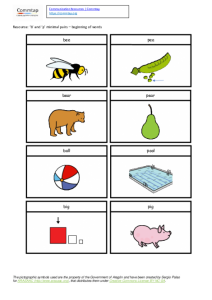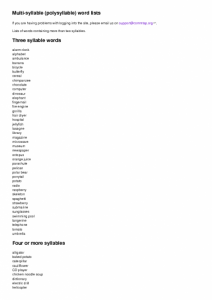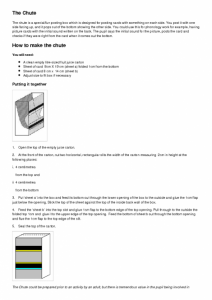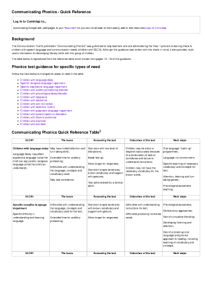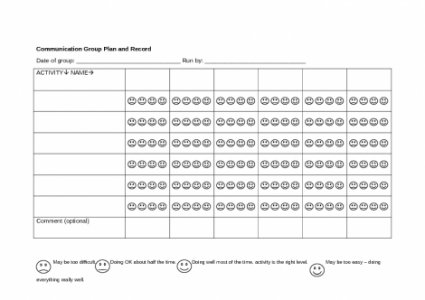Search
User login
Topic “Speech”
What is auditory discrimination - Information Sheet
Created 12 January 2021; updated 24 October 2021.
Resources for Listening and Auditory Discrimination Tasks
Created 12 January 2021; updated 7 December 2021.
Resources for Listening and Auditory Discrimination Tasks
Minimal Pair Resources
- Noisy/quiet sounds
- p and b at the beginning of words
Multi-syllable (polysyllable) word lists
Lists of words containing more than two syllables.
Three syllable words
alarm clock
alphabet
ambulance
banana
bicycle
butterfly
cereal
chimpanzee
chocolate
computer
dinosaur
elephant
fingernail
fire engine
gorilla
hair dryer
hospital
jellyfish
lasagne
library
magazine
microwave
museum
newspaper
octopus
orange juice
parachute
pelican
polar bear
ponytail
potato
radio
raspberry
skeleton
spaghetti
strawberry
submarine
sunglasses
swimming pool
The Chute
The chute is a special/fun posting box which is designed for posting cards with something on each side. You post it with one side facing up, and it pops out of the bottom showing the other side. You could use this for phonology work for example, having picture cards with the initial sound written on the back. The pupil says the initial sound for the picture, posts the card and checks if they were right from the card when it comes out the bottom.
How to make the chute
You will need:
Sources of Information, Support and Additional Resources
Created 10 October 2012; updated 2 August 2025.
Communicating Phonics - Quick Reference
Created 13 June 2012; updated 6 December 2024.
Communicating Phonics - Quick Reference
Background
The Communication Trust's publication "Communicating Phonics" was published to help teachers who are administering the Year 1 phonics screening check to children with speech language and communication needs (children with SLCN). Although this guidance was written with this check in mind, it also provides much useful information for developing literacy skills with this group of children.
The table below is reproduced from the reference table which comes from pages 12 - 16 of this guidance.
Smiley face group progress sheet
Quick therapy/lesson evaluation sheet - using a rating scale of four smiley faces.
The idea is for the child/person to evaluate themselves in terms of how well they were able to do the activity. This helps the person running the activity to select harder or easier activities as time progresses - keeping them at a level where there is generally a high degree of success.
Created 16 February 2012; updated 16 July 2015.
Activities to develop understanding of the concepts front and back
| Activity/strategy name and materials required | How to do the activity | Key principles for doing the activity and comments |
|---|---|---|
| Draw a picture - Paper and drawing materials - Object that looks different at the front/back. | 1. Ask you child to look at the item in front of them and draw a picture of it. 2. Now turn the object around and ask them to take a look at it from the back, and to draw it again. 3. Talk about the pictures using the words "front" and "back" in your descriptions. Ask your child to say which ones show the back of the figure and which ones the front. | |
| Jump on board game |
Support Commtap to keep it online
Thank you for visiting Commtap.
Please read this message as it is extremely important.
- Visitor donations mean we can continue to host over 1,000 free activities to support speech, language, and communication development.
- Visitor donations mean we can continue to provide free resources to address a wide range of communication needs, including limited speech or language, interaction challenges, and needs associated with conditions such as developmental language disorder, autism, and cerebral palsy.
- Visitor donations mean we can continue to provide resources to support the work of speech and language therapists, teachers, teaching assistants, parents, and carers.
- Visitor donations mean we can continue to provide the free key word sign dictionary (bks.org.uk) which has over 2,000 Makaton and Signalong signs.
We know that not everyone is able to afford to pay to access these resources, however, if you can, please make a donation to keep the site going.
Thank you
Google ads on this page are provided by Google Adsense - and their presence does not imply any endorsement by Commtap. Report a problem with an ad on this page. Log in (for free) to avoid seeing Google ads.
